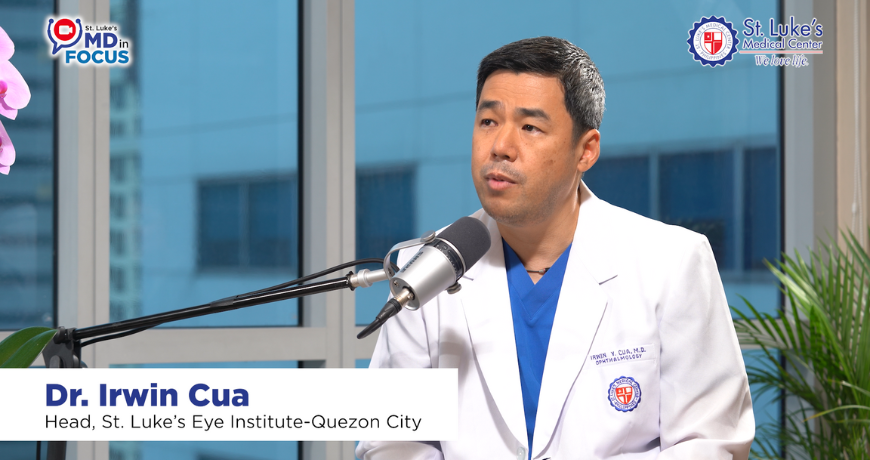Protecting Your Vision: Expert Advice from Dr. Irwin Cua of St. Luke’s Medical Center Eye Institute
Our vision plays a vital role in our daily lives. With aging, environmental stressors, and increased screen time, taking proactive steps to maintain clear and healthy eyesight is essential. Regular eye check-ups and awareness of potential vision problems can help prevent severe conditions and preserve your sight for years to come.
Dr. Irwin Cua, head of the St. Luke's Medical Center Eye Institute in Quezon City, shares valuable insights on how to maintain healthy vision, signs of eye issues, and the latest procedures to correct vision problems.
Regular Eye Exams: Why They're Crucial
For adults over the age of 40, Dr. Cua recommends scheduling an eye exam at least once a year. "If you have other medical illnesses like diabetes or hypertension, maybe 6 months to 1 year. If you are myopic (nearsighted), if you are nearsighted or farsighted, or you have presbyopia (age-related farsightedness), probably at least once a year, have your eyes checked", says Dr. Cua, emphasizing the importance of regular monitoring for those with additional risk factors.
During an eye exam, your doctor will conduct several important tests. The first is a visual test to check how well you can see. This is followed by thorough refraction, where your eye's refractive errors, such as nearsightedness, farsightedness, or astigmatism, are assessed. The next step is a slit-lamp examination, which allows doctors to examine the anterior part of the eye for issues such as cataracts and glaucoma. The retina—the back part of the eye—will also be checked to see if there are any eye diseases.
Early Warning Signs to Look Out For
If you experience any of the following symptoms, it's time to schedule an eye exam:
- Blurry vision
- Eye redness, irritation, or discharge (which could indicate infections or high eye pressure)
- Floaters or flashes of light
- Persistent eye itchiness or pain
Dr. Cua emphasizes that while these symptoms can often be harmless, they should never be ignored.
Common Eye Conditions
One of the most common eye issues Dr. Cua encounters is floaters, which often develop as part of the natural aging process. Floaters occur when the gel inside the eye changes or clumps together, creating specks or threads that float across your vision.
"It is very important that you don't dismiss them because sometimes floaters can mean that they have retinal tears or detachments, especially if it is associated with flashes of light. So if you have floaters and flashes of light, you need an eye check-up. Now, if you have floaters only, you still have your eyes checked because it can be a sign of a maybe a retinal tear or a detachment. If you detect those early, it's easier to treat," advises Dr. Cua. Early detection makes treatment more manageable and helps prevent complications.
Family History and Eye Health
Family history also has something to do with eye conditions. "The most common probably is glaucoma. "If you have a family history of glaucoma, then there's a higher chance for you to get glaucoma," said Dr. Cua. Glaucoma is a condition where increased pressure within the eye damages the optic nerve. He also highlights the importance of getting early checked, "If it's early, then we can control the damage, but if it's late, then it will be more difficult to control it. It can lead to blindness." Glaucoma can be hereditary, so it's essential to get checked if there's a family history of the disease. Early detection and monitoring are crucial to manage the disease and prevent vision loss.
Vision Correction: PRK, LASIK, and SMILE
Several surgical procedures are available to correct vision for those with refractive errors.
Photorefractive Keratectomy (PRK) is the oldest procedure and ideal for patients with thin corneas. However, recovery can take longer, and patients may experience discomfort for a few days.
LASIK, one of the most popular options, offers a quicker recovery and minimal discomfort, allowing most patients to see 20/20 vision the following day. However, it carries a risk of dry eyes and requires special care to protect the eye flap in the early recovery period.
The newest option is Small Incision Lenticule Extraction (SMILE), which has been done in St. Luke's for over 10 years and involves no flap and a smaller incision. This procedure offers faster healing and fewer dry eye issues.
According to Dr. Cua, patients undergo screening first to check which procedure is the ideal and safest for them. "If your cornea is very thin, probably the safest will be PRK. If you have dry eyes, you can do a SMILE instead. If you have a very active lifestyle and are into sports, we recommend SMILE."
Take Action to Protect Your Vision
Dr. Cua emphasizes the importance of a healthy lifestyle and diet. He also suggested the 20-20-20 rule, especially for those using computers. This rule lets you rest your eyes every 20 minutes for 20 seconds and then look at something 20 feet away to reduce eye strain. Lubricating drops can also help relieve dryness.
With today's advanced vision correction procedures—SMILE, LASIK, and PRK—achieving clear eyesight is safer and more effective than ever. Prioritize your eye health today for a brighter, clearer future.
St. Luke's Eye Institute
St. Luke's Medical Center - Global City
2nd Floor, Tan Eng Gee Eye Institute, Main Hospital Building
Rizal Drive cor. 32nd St. and 5th Ave
Taguig City, Philippines
+63-2-8789-7700 ext. 2024
St. Luke's Medical Center - Quezon City
Eye Institute, 1st Floor, Main Hospital
279 E Rodriguez Sr. Ave,
Quezon City, Philippines
+63-2-8723-0101 ext. 5422/4143





